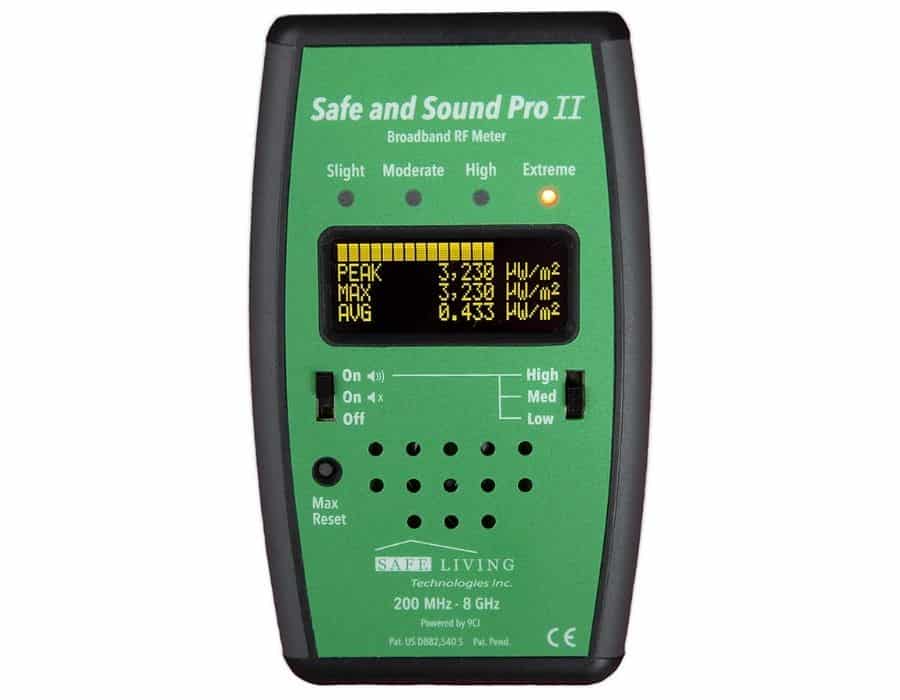As an affiliate, I may collect a share of sales or other compensation from the links on this page.

5G connectivity has sparked a lot of conversations in recent times. While many people are rightly worried about the dangers of EMF radiation, there’s been a lot of effort in some circles to make these worries appear unfounded.
Knowing about the dangers of EMF radiations like 5G, however, you are probably thinking of getting an EMF meter to measure 5G radiation. Will it work, though?
EMF meters can measure some frequencies of 5G radiation. However, since 5G technology is rolling out across a wide range of frequencies, it is not easy to find an EMF meter that can measure all the existing 5G frequencies. You may need multiple meters to get accurate measurements.
Check out my guide on 5G radiation measurement.
In this article, we’ll take a closer look at EMF meters and how you can pick the right ones. There’s also a section on whether you should worry about 5G radiations or not.
What Is an EMF Meter?
An EMF (electromagnetic field) detector is a special device used to read electromagnetic fields. It’s made up of highly-sensitive components which have the capacity to pick up fluctuations in the amount of electric or magnetic energy in any given space.
With an increasing number of tech devices and new strides in connectivity, EMF meters have become useful, as more people try to investigate the effects of electric or magnetic energy on humans.
Types of EMF Meters
Also known as electromagnetic radiation meters, EMF meters are divided into different groups based on the type of radiation they typically measure.
- Radioactivity meters generally measure A and B particles, X rays, and gamma rays.
- Low-frequency radiation meters are used to measure electric and magnetic fields in power cables, electronic devices, transformers, etc.
- High-frequency radiation meters are the ones you should be concerned about here. They are used to measure electromagnetic fields from cordless phones, Bluetooth devices, wireless internet, cell phones, and phone network masts. They can also measure electromagnetic fields from microwave ovens, TV and radio antennas, etc.
EMF meters can measure AC or DC electromagnetic fields. Pricier models are able to measure both. EMF meters are also further grouped based on the number of axes they can measure into single and tri-axis meters.
Single-axis meters measure one dimension on the field. This means you have to tilt and turn the meters multiple times to get a complete measurement. Tri-axis meters, on the other hand, can generate full-field measurements quickly because they measure three axes at once. They are, therefore, costlier than single-axis meters.
Why Are EMF Meters Useful?
An EMF meter can be useful in the following ways:
- It can help you to identify sources of radiation so you can either remove or replace them, depending on the situation.
- You can find out radiation hotspots and stay away from them. These hotspots are areas where you are exposed to unsafe levels of high-frequency radiation.
- You can measure the radiation levels in an area after you’ve implemented electromagnetic shielding techniques.
Can You Measure 5G Radiation With an EMF Meter on Your Own?
Check out my guide on reading EMF meters.
Radiation measurement has become a hot niche in recent years, so the EMF meters in the market are designed with simplicity in mind.
In many cases, you only have to turn on the meter in the space you’d like to test for radiation, and then check the readings that will appear on the screen after a few minutes. You can then crosscheck the readings received with acceptable radiation limits.
Is 5G Dangerous? Do You Really Need an EMF Meter for It?
As we mentioned above, there’s been a lot of debate around the safety of 5G networks and other forms of EMF radiation. However, for every dismissive post about the potential dangers, there are dozens more like this one asking the hard questions.
The major talking point used to push the safety of EMF radiations is that they are non-ionizing. However, research has since shown that this fact doesn’t make EMF radiations safe. In 2011, the WHO-backed International Agency for Research on Cancer (IARC) stated that EMFs are possibly carcinogenic to humans.
In another study, researchers discovered that people exposed to high levels of EMF for long periods had an increased risk of certain types of leukemia. This study showed that there’s a link between EMF exposure in humans and negative changes in the nerve functions in charge of mood and sleep.
The International Commission on Non-Ionizing Radiation Protection (ICNIRP) has a guideline on what they think are acceptable levels of EMF exposure, but as this post rightly points out, over 500 studies have since shown that these so-called acceptable levels are not 100% harmless.
Based on the results of these studies, over 240 scientists have signed the International EMF Scientist Appeal, pushing for stronger exposure limits
So, is 5G dangerous? Yes, it is, just like other EMF radiations. Getting an EMF meter to ensure you are not exposed to too much of it and other types of EMF radiation is a good decision.
Also read, Finding 5G Towers Near Me (3 Quick Ways)
EMF Meters That Can Measure 5G Connectivity

There are a few EMF meters that you can consider using if you live in a region that already has 5G technology deployed, and you’re curious about the level of exposure you’re getting exposed to. Here are some:
Safe and Sound Pro 2
See the Amazon listing
This durable, hand-held EMF meter is one you can use to measure 5G frequencies that are 12 GHz and below. It is a model from the Safe Living Technologies brand. You can count on it to pick on 5G frequencies from 200 MHz to 8 GHz.
The device comes with 15-hour battery life, giving you ample use time even when you are out and about. You’ll also get a bar graph showing you the intensity of readings. Are you electrically hypersensitive? The low EMF emissions of the meter make this a good option to consider.
The Acoustimeter AM11
See the Amazon listing
This is one of the best RF meters on the market today. It is not quite as powerful as the Safe and Sound Pro 2, because it only measures 5G frequencies up to 8 GHz. However, it is very accurate and simple to use. Its accuracy is as a result of its ultra-detailed directional sensitivity. It ensures you can easily pinpoint the direction of the 5G waves.
The device is, however, bulky and a bit pricey. It’s probably not an option if you just need an EMF meter out of curiosity or if you intend to carry it around frequently. However, when you do have to carry it around, you don’t have to worry about power as it can last 20 hours on a single charge.
Tips for Buying an EMF Meter
If you’d prefer to get another EMF meter outside of the two we have covered above, here are some tips to keep in mind:
- Choose one that matches the 5G frequency in your area. As you’ve seen above, your meter won’t pick anything if the 5G frequency around you is out of its limits.
- Check for the manufacturer’s reputation. Are they well known in the industry? Buying from trusted brands is the only way to be sure you’re getting accurate readings.
- Choose a device that is simple to use. You should be able to intuitively use the meter or at least be able to use it after watching a few minutes of tutorials.
- Check for added features. What other types of radiations can the EMF meter pick up? Does it come with decent battery life? How are the readings presented on the screen?
Conclusion
EMF meters can measure 5G radiation, but only if you get a model that can pick up the 5G frequencies in your area. Therefore, the first step to measuring 5G radiation is to, first of all, find out the frequencies in your region.
Once you are sure of the numbers, you can then look at the EMF meters in the market that can pick up the frequencies using the tips we’ve covered above.